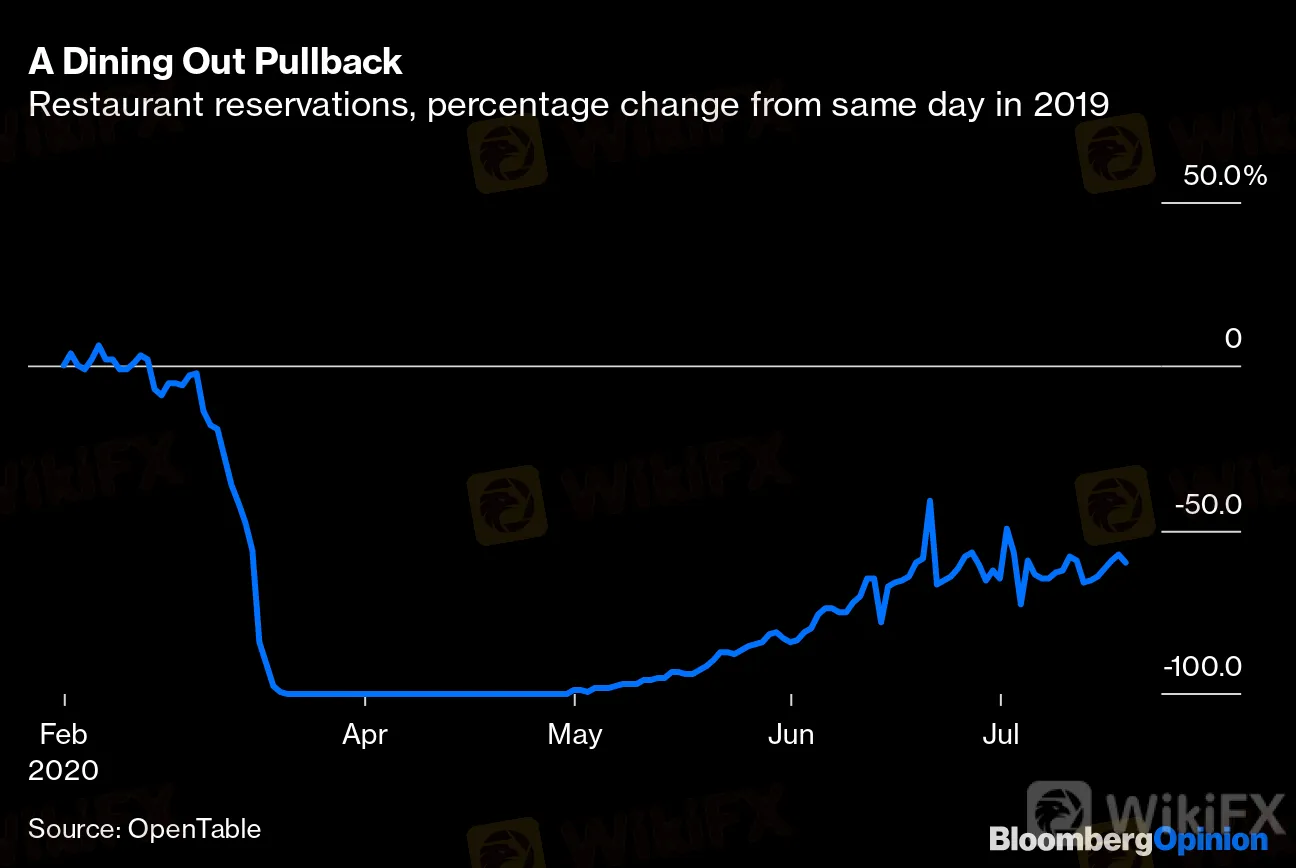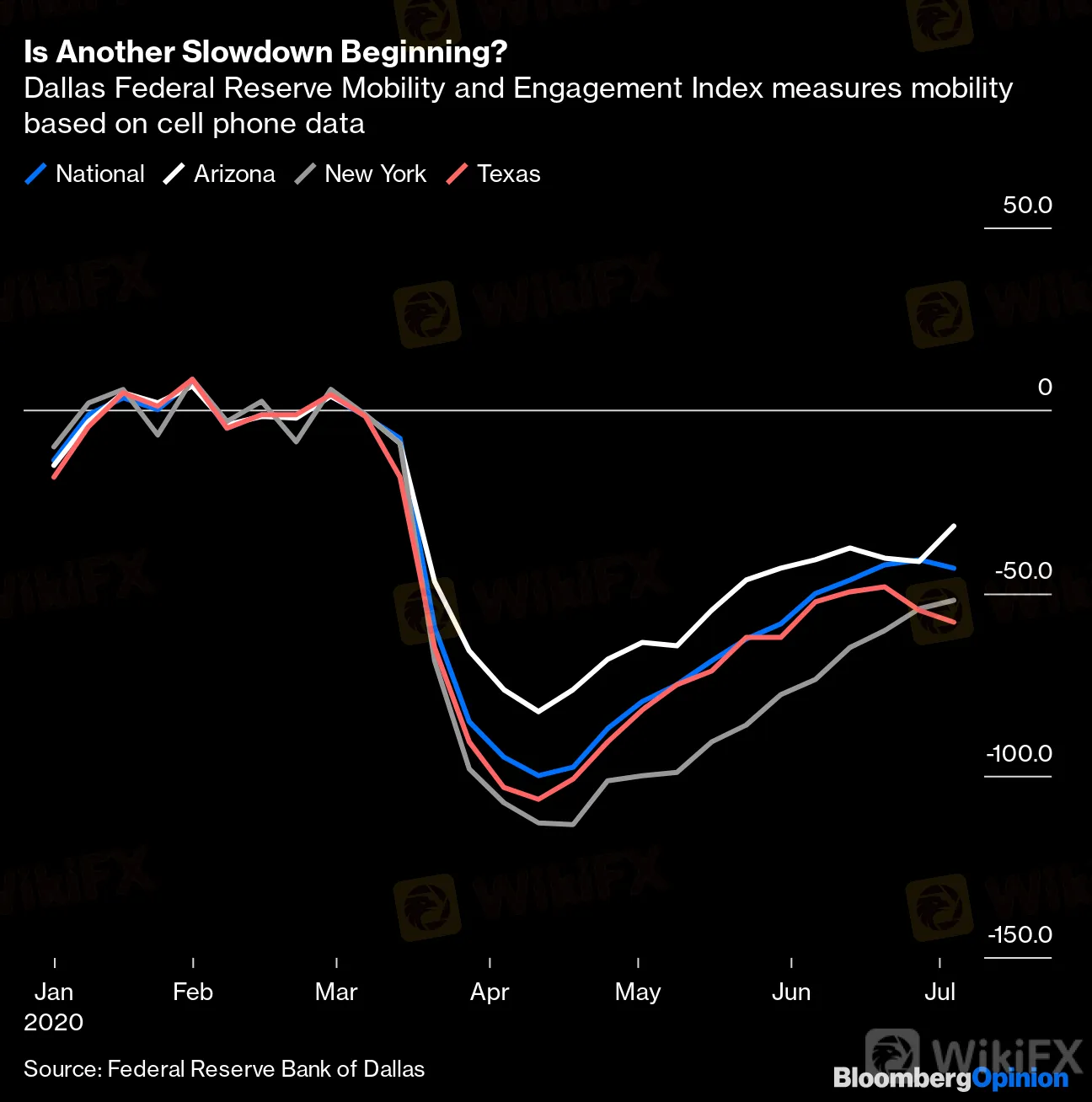简体中文
繁體中文
English
Pусский
日本語
ภาษาไทย
Tiếng Việt
Bahasa Indonesia
Español
हिन्दी
Filippiiniläinen
Français
Deutsch
Português
Türkçe
한국어
العربية
The U.S. Is on the Verge of Lockdown 2.0
Abstract:Governments will have no choice but to ban behavior that spreads Covid-19. The public will do the rest by shutting in again.
After two months of what looked like a nascent recovery, the U.S. economy is faltering again. Restaurant reservations, one of the most commonly tracked indicators of local business activity, are stagnating:
A Dining Out Pullback
Restaurant reservations, percentage change from same day in 2019
Source: OpenTable

Americans are also a bit less mobile in July than in June:
Is Another Slowdown Beginning?
Dallas Federal Reserve Mobility and Engagement Index measures mobility based on cell phone data
Source: Federal Reserve Bank of Dallas

It‘s not hard to see what’s happening. With Covid-19 infections surging in Sun Belt states and a few other states experiencing second waves, Americans are being rationally prudent and staying home. The fear this time isn‘t as great as in March, when much less was known about the disease, but it’s still enough to tank the recovery.
The key to restarting the recovery, therefore, is to suppress the virus. For cities and states where the epidemic has subsided, the best tools for preventing new outbreaks are universal mask usage, plentiful testing, prompt contact tracing and isolation of the infected. But President Donald Trump, apparently subscribing to the theory that ignoring the virus will make it go away, is attempting to block funding for testing and tracing. And for states such as Texas, Florida and Arizona that have been overwhelmed with new infections, this approach -- although still useful -- wont be enough.
New lockdowns of some sort are going to be necessary. Some cities are already considering a return to stringent stay-at-home orders of the type used in the spring. Those lockdowns probably didnt hurt the economy any more than the virus itself. But this time things might be different. Because fear of the virus is less intense than in March, blanket lockdowns that were superfluous last time might curtail the economy now. In addition, psychological stress from prolonged isolation might be fueling social unrest.
Fortunately, we understand much more about the virus than we did four months ago, and what weve learned can help us design new lockdown policies that are much less restrictive and just as effective as the old ones. Outside activities seem to be much less dangerous than inside ones, and brief contact is considerably less risky than prolonged contact. The most dangerous activities are places where people are talking loudly in a crowded indoor setting for a long time -- bars, parties, concerts, indoor sporting events, indoor religious services and so on. Offices, gyms, hair salons and indoor restaurants are somewhat dangerous.
New lockdowns, therefore, should focus on banning only the highest-risk activities. Bars, clubs and other drinking establishments should be closed through the end of the year. This will hit local businesses hard, so Congress should create a bailout fund specifically for bars and similar establishments. Similarly, indoor sporting, music and theater should be halted for the duration of the epidemic, and companies that rely on these should be bailed out accordingly.
Indoor social gatherings over a certain size should also be banned in hard-hit areas. This will require strict enforcement because people are apt to defy the law and throw parties. Religious services and college classes should be held remotely.
Moderately dangerous environments -- offices, hair salons, and so on -- should be required to use strict protections against the disease. Physical distancing, universal mask-wearing, ventilation and physical barriers should be mandatory. States, and Congress, will need to provide funds to help pay for these needed modifications.
K-12 schools are the hardest case. Keeping kids in the house forever exerts a significant toll on parents, while hurting learning outcomes. But kids, especially older ones, can pick up the virus at school and spread it to their family members, and teachers are afraid to return to the classroom. The best solution may be a compromise -- open schools with strict social distancing measures, physical barriers, and masks, and using remote learning when those other measures arent possible.
But equally important to what states and cities close is what they leave open. Outdoor activities seem to be very low-risk, especially with masks on. Parks, beaches and other open areas can help people preserve their mental and physical health for very little virus risk. Retail, meanwhile, can be safe if everyone wears a mask and keeps a reasonable distance within the store.
So the new rounds of lockdowns can afford to be smarter than the first. Nightlife, indoor events and house parties cant be allowed, but most other activities are possible with adequate precautions. That will allow Americans to return to a semblance of normal life, even in areas with high infection rates. And with vaccines and antibody treatments showing promise in trials, even these restrictions may only have to last a few months.
This sort of lockdown lite probably has the highest economic return of any policy that governments can do right now. They will hurt the economy only minimally, and they will hasten the day when the epidemic is no longer scaring people into staying home.
Disclaimer:
The views in this article only represent the author's personal views, and do not constitute investment advice on this platform. This platform does not guarantee the accuracy, completeness and timeliness of the information in the article, and will not be liable for any loss caused by the use of or reliance on the information in the article.
WikiFX Broker
Latest News
Brazilian Man Charged in $290 Million Crypto Ponzi Scheme Affecting 126,000 Investors
Become a Full-Time FX Trader in 6 Simple Steps
ATFX Enhances Trading Platform with BlackArrow Integration
IG 2025 Most Comprehensive Review
SEC Drops Coinbase Lawsuit, Signals Crypto Policy Shift
Construction Datuk Director Loses RM26.6 Mil to UVKXE Crypto Scam
Should You Choose Rock-West or Avoid it?
Franklin Templeton Submitted S-1 Filing for Spot Solana ETF to the SEC on February 21
Scam Couple behind NECCORPO Arrested by Thai Authorities
Top Profitable Forex Trading Strategies for New Traders
Currency Calculator






